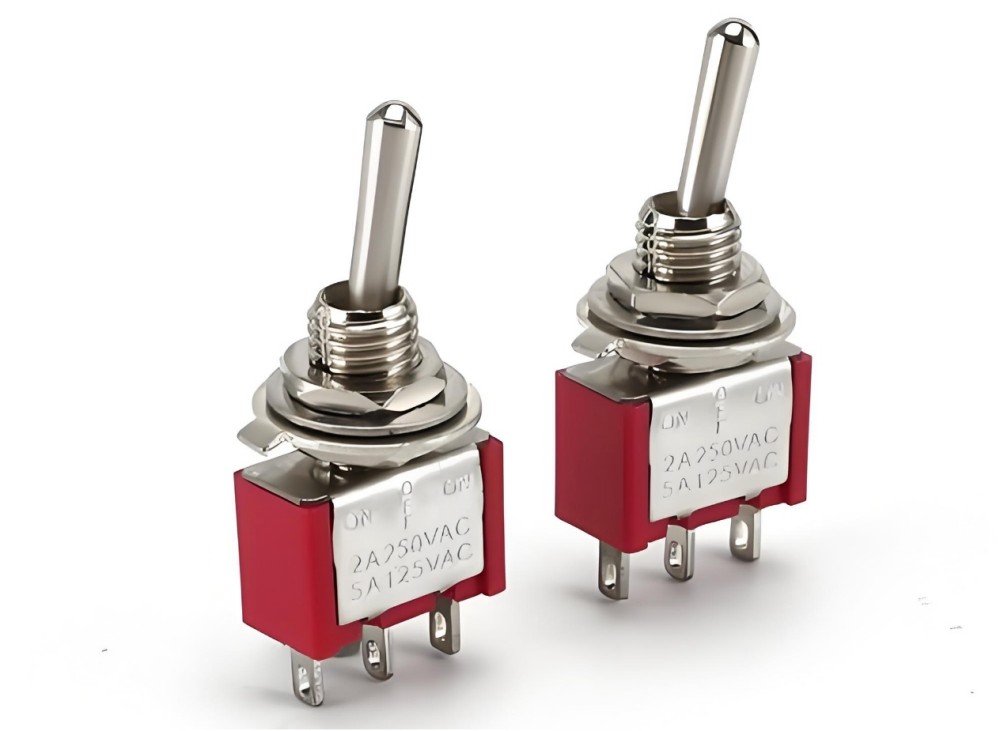
Toggle switches are essential components used in a wide variety of electrical and electronic systems. They offer a simple, reliable method for controlling electrical circuits, making them one of the most commonly used switches in everyday applications.
From basic on/off operations to more complex multi-position circuits, toggle switches are versatile and adaptable to many environments.
This comprehensive guide will explore the different types of toggle switches, their structure, how they work, common troubleshooting tips, and key considerations for wiring and installation.
What Is a Toggle Switch?

A toggle switch is an electromechanical device used to control the flow of electricity in a circuit. Typically, the switch consists of a lever or handle that can be flipped between two or more positions (e.g., on/off, or between multiple circuits). This movement of the toggle helps either open or close a circuit, controlling the flow of electricity.
While toggle switches are simple in design, they are durable, reliable, and incredibly versatile. Their tactile feedback and ease of operation make them ideal for use in many industrial, automotive, consumer electronics, and household applications.
What Is the Structure of a Toggle Switch?
The structure of a toggle switch is relatively simple but incorporates several key components that work together to ensure it functions effectively. While the specific design may vary depending on the type of toggle switch, most toggles share these common structural elements:
- Actuator (Lever or Toggle)
The actuator, or toggle, is the part of the switch that the user manipulates. It is usually a lever that moves between two or more positions, such as on/off or multiple circuit options. The movement of the actuator is what causes the internal contacts to either open or close the circuit.
- Contacts
The contacts inside a toggle switch are responsible for completing or interrupting the electrical circuit. When the toggle is in the “on” position, the contacts are closed, allowing current to flow. When the switch is in the “off” position, the contacts are open, cutting off the current.
- Terminals
Terminals are the external connectors of the switch, where the electrical leads are connected. These terminals allow the switch to interface with the rest of the electrical system, either by providing a power source (input) or directing current to the load (output).

- Housing or Enclosure
The housing is the outer shell that protects the internal components from external factors, such as dust, moisture, or physical damage. It is often made from durable materials like plastic or metal, depending on the type of environment the switch will be used in.
- Spring Mechanism (Optional)
Some toggle switches include a spring mechanism that returns the actuator to its default position when released. This is commonly found in momentary toggle switches, which are designed to activate a circuit only while the switch is being pressed.
Types of Toggle Switches
There are several different types of toggle switches, each designed for specific applications. The type of switch you choose depends on your specific needs, such as the number of circuits you wish to control and the kind of functionality you require.
- Single Pole Single Throw (SPST)
The SPST toggle switch is the simplest type, with two positions: on and off. It controls a single circuit and is typically used in basic on/off applications, such as for lights or small electrical devices.
- Single Pole Double Throw (SPDT)
The SPDT switch has three positions: off, on to one circuit, and on to another. This type of toggle switch is useful when you need to select between two circuits or functions, such as toggling between power sources or selecting between multiple channels in audio equipment.
- Double Pole Single Throw (DPST)
A DPST switch controls two separate circuits simultaneously. Each circuit can be turned on or off independently, making it useful for applications where you want to control two devices or systems at the same time using a single switch.
- Double Pole Double Throw (DPDT)
The DPDT switch offers two separate circuits with two positions for each circuit. It allows for greater flexibility and control, often used in applications where you need to reverse the direction of a motor or switch between multiple sets of devices.
- Momentary Toggle Switches
Momentary toggle switches are designed to remain activated only while the user is pressing or toggling the switch. Once released, the switch returns to its default position. These are used when a temporary action is needed, such as triggering a circuit or resetting a device.
- Illuminated Toggle Switches
These switches incorporate an LED light or other illumination to show the status of the circuit. They are especially useful in environments where visual confirmation of the switch’s position is necessary, such as in low-light conditions or for indicating the on/off status.
How Does a 12V Rocker Switch Work?
A 12V rocker switch operates similarly to other types of toggle switches but is specifically designed for 12V electrical systems, which are commonly found in automotive and low-voltage applications.
Here’s how it works:
Basic Operation: The user toggles the switch to either the “on” or “off” position. In the “on” position, the switch completes the circuit, allowing electrical current to flow through, powering the connected device. In the “off” position, the circuit is interrupted, and no current flows.
Electrical Contacts: Inside the switch, there are internal contacts that close or open depending on the position of the switch. In the “on” position, the contacts are closed, allowing current to flow to the load (device). In the “off” position, the contacts open, cutting off the current.
Rocker Mechanism: The rocker mechanism provides a larger surface for the user to operate, making it easier to toggle between positions. This is particularly useful in automotive applications, where toggling needs to be done quickly and easily, often in cramped or low-visibility environments.
Illumination (Optional): Many 12V rocker switches come with built-in illumination, typically using LEDs, which lights up when the switch is turned on. This provides visual confirmation of the switch’s status, making it ideal for use in vehicles or low-light settings.
Durability: Designed to handle 12V DC circuits, these switches are built to be durable and reliable, capable of withstanding frequent use in harsh conditions.
Applications of Toggle Switches


Toggle switches are widely used across various sectors due to their reliability and ease of operation. In the automotive industry, these switches are commonly employed to control lights, horns, and other electrical components within vehicles. In industrial settings, toggle switches play a vital role in operating machinery and managing equipment in factories and plants, ensuring seamless operations. When it comes to consumer electronics, toggle switches are frequently found in appliances and devices, providing a straightforward method for power control.
In the aerospace sector, toggle switches are crucial for managing various control functions in aircraft, where reliability and precision are paramount. Similarly, in the marine industry, boats utilize toggle switches to control various electrical systems, from navigation lights to power distribution. Moreover, toggle switches are also integrated into home automation systems, where they offer an easy way to control lighting, security systems, and other smart devices within a connected home.
Wiring Toggle Switches
Basic Wiring for SPST Switch
For an SPST switch, the wiring is straightforward:
- Connect the power source to one terminal of the switch.
- Connect the load (device to be controlled) to the other terminal.
- Ensure all connections are secure and insulated as necessary.
Wiring for SPDT Switch
An SPDT switch has three terminals:
- Connect the common terminal to the power source.
- Connect the two other terminals to the two circuits you wish to switch between.
- The switch will direct the current to one of the two circuits based on its position.
Wiring for DPST and DPDT Switches
For DPST and DPDT switches, the wiring involves multiple circuits:
- For DPST, connect each pole to a separate circuit.
- For DPDT, connect the common terminals to the power source and the other terminals to the respective circuits.
- Ensure that the switch positions correctly correspond to the desired circuits.
Always refer to the manufacturer’s wiring diagram for specific instructions and safety precautions.
Troubleshooting Common Issues with Toggle Switches
Like any mechanical or electrical component, toggle switches can sometimes encounter issues. Below are some common problems and troubleshooting tips:
1. Switch Does Not Turn On or Off
- Cause: Loose connections, faulty internal contacts, or a broken switch mechanism can prevent the switch from functioning properly.
- Solution: Inspect the wiring and connections to ensure they are secure. If the switch is faulty, it may need to be replaced. Make sure the terminals are properly connected and free from corrosion or debris.
2. Switch Feels Loose or Wobbly
- Cause: This can occur if the internal components are worn out or if the switch is not securely mounted.
- Solution: Tighten the mounting screws or replace the switch if it is worn. Ensure that the actuator is properly aligned and not damaged.
3. Switch Sticks or Doesn’t Return to Default Position
- Cause: If the toggle switch is a momentary type and does not return to its default position, the spring mechanism may be damaged or obstructed.
- Solution: Check for obstructions or dirt inside the switch. If the spring is damaged, the switch may need to be replaced.
4. Illuminated Toggle Switch Not Lighting Up
- Cause: The LED light inside the switch may have burned out, or there may be a problem with the power supply.
- Solution: Check the power source to ensure it is supplying the correct voltage. If the LED is faulty, replacing the switch may be necessary.
Conclusion
Toggle switches are essential components used to control electrical circuits across a wide range of applications. Their simplicity, reliability, and versatility make them ideal for use in industrial, automotive, consumer electronics, and other electrical systems.
By understanding the structure, types, and operation of toggle switches, you can make informed decisions about which switch is best for your needs. Additionally, knowing how to troubleshoot common issues and how to wire these switches properly ensures their effective operation and long-lasting performance.
Whether you’re installing a 12V rocker switch in a vehicle or using a momentary toggle switch in industrial machinery, toggle switches provide an easy, dependable way to manage electrical systems.




